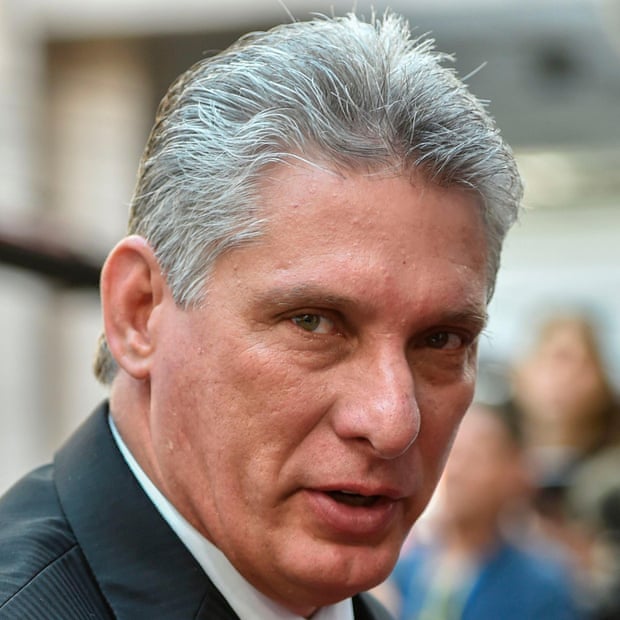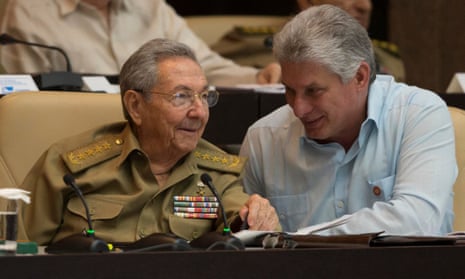The Cuban government has selected the country’s 57-year-old first vice-president, Miguel Díaz-Canel, as the sole candidate to succeed President Raúl Castro in a transition aimed at ensuring the country’s single-party system outlasts the ageing revolutionaries who created it.
The certain approval of Díaz-Canel by members of the unfailingly unanimous National Assembly will install someone from outside the Castro family at the head of the country’s government office for the first time in nearly six decades.
The 86-year-old Castro will remain head of the Communist party, designated by the constitution as “the superior guiding force of society and the state”. As a result, Castro will remain the most powerful person in Cuba for the time being. His departure from the presidency is nonetheless a symbolically charged moment for a country accustomed to 60 years of absolute rule first by revolutionary leader Fidel Castro and, for the last decade, his younger brother.
Facing biological reality but still active and apparently healthy, Raúl Castro is stepping down as president in an effort to guarantee new leaders can maintain the government’s grip on power in the face of economic stagnation, an ageing population and increasing disenchantment among younger generations.
ProfileWho is Miguel Díaz-Canel?
Show

Career
An electronics engineer by training, Díaz-Canel became party chief in his home province of Villa Clara in the 1990s. In 2003, he was moved to be party chief in Holguin province, a centre of Cuba's burgeoning tourism industry and foreign investment. In 2009, he was summoned to Havana to be higher education minister, and in 2013 Castro appointed him as first-vice president. Since then he has stood in for Castro at political events, received foreign dignitaries and travelled abroad on behalf of the government.
Political views
Díaz-Canel's policy views remain mostly an enigma in a country where political campaigning is banned. On the one hand he is from a younger generation of leaders and has advocated modernising Cuba; on the other he is a longtime Communist party apparatchik who is not expected to push for sweeping political change.
As a young provincial party chief, he bucked party orthodoxy by backing an LGBT-friendly cultural centre in Santa Clara, reportedly listening to rock music and sporting long hair. At a national level, he called for more critical coverage of events in state-run media and broader internet access to open one of the world's least web-connected societies.
Ultimately though, he appears to have earned Castro's trust by sticking to the party line on key political and economic issues, analysts say.
Personality
While Díaz-Canel's public persona has been reserved, even dour, since he joined the national government nine years ago, residents in his home province of Villa Clara enthuse about him as a handsome, friendly "man of the people" who gets things done.
Fuel was so scarce in the 1990s that he cycled to work wearing shorts instead of commuting by Soviet-made Lada like other party leaders, locals said. He has also been lauded for backing the Santa Clara culture centre at a time when homophobia was commonplace in the party.
A music lover, Díaz-Canel would reportedly bring his two children from his first marriage to the centre's youth events, dancing there himself in the evenings. Reuters
“I like sticking with the ideas of President Fidel Castro because he did a lot for the people of Cuba, but we need rejuvenation, above all in the economy,” said Melissa Mederos, a 21-year-old schoolteacher. “Díaz-Canel needs to work hard on the economy, because people need to live a little better.”
“We’re building a relationship between the government and the people here,” Díaz-Canel said after casting a ballot for members of the National Assembly. “The lives of those who will be elected have to be focused on relating to the people, listening to the people, investigating their problems and encouraging debate.”
Díaz-Canel gained prominence in central Villa Clara province as the top Communist party official, a post equivalent to governor. There, people described him as a hard-working, modest-living technocrat dedicated to improving public services. He became higher education minister in 2009 before moving into the vice presidency.
In a video of a Communist party meeting that leaked to the public last year, Díaz-Canel expressed a series of orthodox positions that included pledging to shut some independent media and labelling some European embassies as outposts of foreign subversion.
But he has also defended academics and bloggers who became targets of hardliners, leading some to describe him a potential advocate for greater openness in a system intolerant of virtually any criticism or dissent. International observers and Cubans alike will be scrutinising every move he makes after he officially takes office on Thursday.
Two years after taking over from his ailing brother in 2006, Castro launched a series of reforms that expanded Cuba’s private sector to nearly 600,000 people and allowed citizens greater freedom to travel and access to information. He has failed to fix the generally unproductive and highly subsidised state-run businesses that, along with a Soviet-model bureaucracy, employ three of every four Cubans. State salaries average $30 a month, leaving workers struggling to feed their families, and often dependent on corruption or remittances from relatives overseas.
Castro’s moves to open the economy have largely been frozen or reversed as soon as they began to generate conspicuous shows of wealth by the new entrepreneurial class in a country officially dedicated to equality among its citizens.
“I don’t want to see a capitalist system, hopefully that doesn’t come here, but we have to fix the economy,” said Roberto Sanchez, a 41-year-old construction worker. “I’d like to have more opportunity, to buy a car and have a few possessions.”
State media went into overdrive on Wednesday with a single message: Cuba’s system is continuing in the face of change. Commentators on state television and online offered lengthy explanations of why Cuba’s single-party politics and socialist economy are superior to multi-party democracy and free markets.
Fidel Castro was president from 1976 until he fell ill in 2006, having previously led the country since the 1959 revolution as prime minister. Osvaldo Dorticos was president from 1959 to 1976 but was considered a figurehead beside the man who forged Cuba’s single-party socialist system and ruled by fiat.
